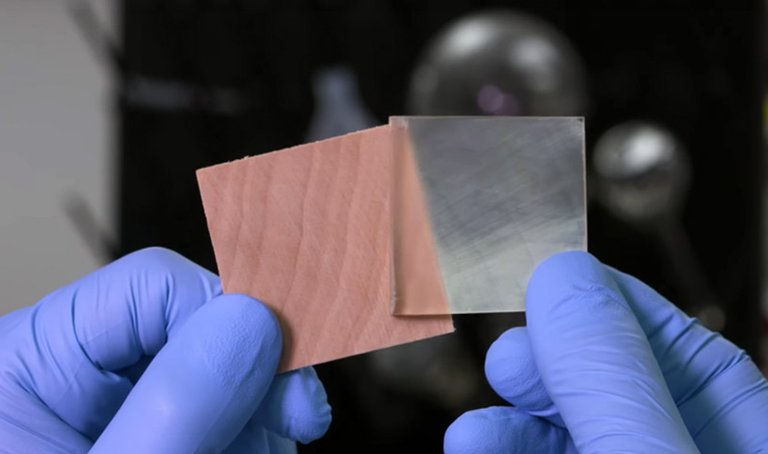
A deslignificação é um processo químico que remove ou reduz a quantidade de lignina na madeira, deixando-a com uma estrutura mais porosa e maleável. Esse processo tem sido cada vez mais utilizado na engenharia da madeira, pois a lignina é um composto que pode dificultar a penetração de outras substâncias na estrutura da madeira, limitando suas propriedades.
Uma das aplicações mais promissoras da deslignificação é na produção de bioeletricidade. Segundo Li et al. (2020), a deslignificação pré-tratamento da biomassa lignocelulósica pode aumentar a eficiência da produção de bioeletricidade em até 50%. Isso ocorre porque a remoção da lignina torna a celulose e a hemicelulose mais acessíveis às enzimas que as convertem em açúcares, que são então fermentados para produzir eletricidade.
Outra aplicação da deslignificação é na produção de madeira translúcida. Esse material é produzido através da remoção da lignina da madeira, o que deixa as fibras mais transparentes e permite a passagem de luz. Segundo Zhu et al. (2016), a madeira translúcida pode ser utilizada em aplicações arquitetônicas e de design de interiores, proporcionando uma aparência única e moderna.
Além disso, a deslignificação também é utilizada na produção de madeira em gel para isolamento térmico. De acordo com Wang et al. (2017), a madeira em gel pode ser produzida através da deslignificação da madeira seguida de uma etapa de re-gelificação. Esse material possui propriedades isolantes superiores aos materiais tradicionais, além de ser mais sustentável e renovável.
Além das aplicações citadas anteriormente, a deslignificação também tem sido utilizada para melhorar a resistência mecânica da madeira. A remoção da lignina resulta em uma estrutura mais porosa e flexível, o que permite que a madeira deslignificada suporte mais carga antes de quebrar ou deformar.
Um estudo realizado por Yang et al. (2018) demonstrou que a deslignificação da madeira de balsa resultou em uma melhoria significativa na resistência à compressão do material. A madeira deslignificada apresentou uma resistência à compressão quase três vezes maior do que a madeira não tratada.
Essa propriedade da madeira deslignificada pode ser aplicada em várias áreas, como na construção civil, na fabricação de móveis e na indústria naval. A madeira deslignificada pode ser utilizada em estruturas que suportam cargas, proporcionando maior segurança e durabilidade.
Referências:
LI, N., et al. Improved bioelectricity generation from lignocellulosic biomass by integrating desilication and alkaline pretreatment. Journal of Cleaner Production, v. 261, p. 121184, 2020.
ZHU, B., et al. Optically Transparent Wood from a Nanoporous Cellulosic Template: Combining Functional and Structural Performance. Biomacromolecules, v. 17, n. 4, p. 1358-1364, 2016.
WANG, L., et al. Highly effective thermal insulation of hierarchical porous structure of delignified wood. Journal of Materials Chemistry A, v. 5, n. 39, p. 20724-20731, 2017.
YANG, S., et al. High-strength wood materials reinforced by cellulose nanocrystals derived from wood flour. Composites Science and Technology, v. 168, p. 307-313, 2018.
Delignification in wood engineering.
Delignification is a chemical process that removes or reduces the amount of lignin in wood, leaving it with a more porous and flexible structure. This process has been increasingly used in wood engineering because lignin can hinder the penetration of other substances into the wood structure, limiting its properties.
One of the most promising applications of delignification is in the production of bioelectricity. According to Li et al. (2020), pre-treatment delignification of lignocellulosic biomass can increase bioelectricity production efficiency by up to 50%. This is because the removal of lignin makes cellulose and hemicellulose more accessible to enzymes that convert them into sugars, which are then fermented to produce electricity.
Another application of delignification is in the production of translucent wood. This material is produced by removing lignin from wood, which makes the fibers more transparent and allows the passage of light. According to Zhu et al. (2016), translucent wood can be used in architectural and interior design applications, providing a unique and modern appearance.
In addition, delignification is also used in the production of wood gel for thermal insulation. According to Wang et al. (2017), wood gel can be produced by delignifying the wood followed by a gelation step. This material has superior insulation properties compared to traditional materials, in addition to being more sustainable and renewable.
In addition to the aforementioned applications, delignification has also been used to improve the mechanical strength of wood. The removal of lignin results in a more porous and flexible structure, allowing delignified wood to withstand more load before breaking or deforming.
A study conducted by Yang et al. (2018) demonstrated that delignification of balsa wood resulted in a significant improvement in compressive strength. Delignified wood showed nearly three times higher compressive strength than untreated wood.
This property of delignified wood can be applied in various areas, such as construction, furniture manufacturing, and the shipbuilding industry. Delignified wood can be used in load-bearing structures, providing greater safety and durability.
References:
LI, N., et al. Improved bioelectricity generation from lignocellulosic biomass by integrating desilication and alkaline pretreatment. Journal of Cleaner Production, v. 261, p. 121184, 2020.
ZHU, B., et al. Optically Transparent Wood from a Nanoporous Cellulosic Template: Combining Functional and Structural Performance. Biomacromolecules, v. 17, n. 4, p. 1358-1364, 2016.
WANG, L., et al. Highly effective thermal insulation of hierarchical porous structure of delignified wood. Journal of Materials Chemistry A, v. 5, n. 39, p. 20724-20731, 2017.
YANG, S., et al. High-strength wood materials reinforced by cellulose nanocrystals derived from wood flour. Composites Science and Technology, v. 168, p. 307-313, 2018.



Comments